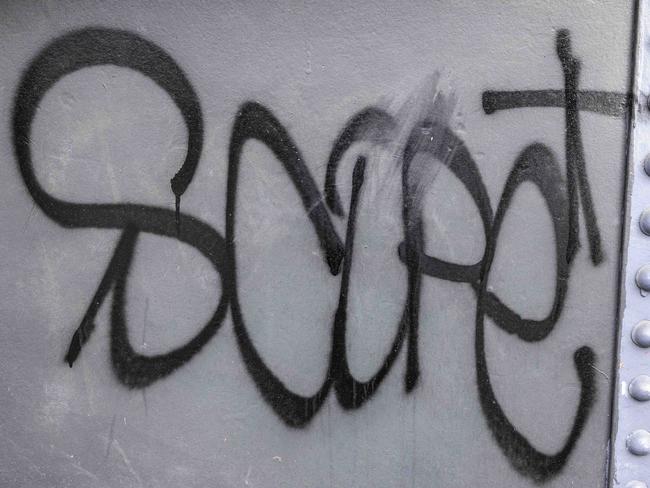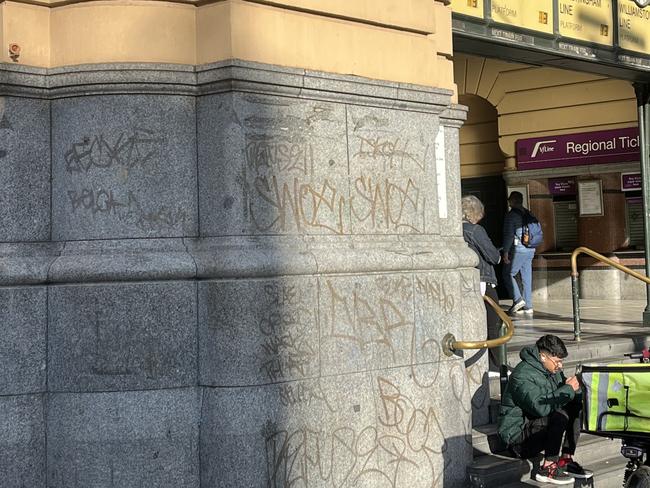Lord mayoral candidate Arron Wood promises to crack down on illegal graffiti in Melbourne
Arron Wood has unveiled his three-part plan to control illegal graffiti in Melbourne if he becomes the city’s next lord mayor, which could lead to vandals being ordered to scrub off graffiti.

Victoria
Don't miss out on the headlines from Victoria. Followed categories will be added to My News.
Lord mayoral candidate Arron Wood has pledged to push for stricter penalties for vandals – including an order they scrub off graffiti as part of their community service – and to speed up the graffiti removal process if he is elected to the city’s top job.
The Sunday Herald Sun can reveal that Mr Wood, who is taking on Lord Mayor Nick Reece in the October council election, will on Sunday unveil his three-part plan to not only clean, but control, illegal graffiti across Melbourne’s CBD.
Mr Wood, who served as former deputy lord mayor and acting lord mayor from 2016 to 2020, said his policy was a response to the “failings of the current administration”.
“People are sick of the endless announcements of graffiti blitzes with no action from the Town Hall leadership,” Mr Wood said.
“The City of Melbourne deserves better than a Lord Mayor who is more concerned about winning an election than getting anything done.”

He said the City of Melbourne’s approach to graffiti must be three-fold to focus not only on the court system and the clean-up, but to stop it from occurring in the first place.
“We will collaborate with the appropriate legislative bodies to advocate for the introduction of strict penalties for offenders, similar to those in place in other jurisdictions such as Chicago, New York and Sydney, including fines, community service and the ability for the pursuit of civil damages to function as a deterrent against illegal graffiti,” Mr Wood said.
He added that he would advocate for vandals charged with property damage offences to be required to clean off graffiti as part of their community service to “ensure that taxpayers are not burdened with the clean-up bill”.

Mr Wood also proposes, if elected, to establish a taskforce made up of representatives from key agencies including Yarra Trams, Metro Trains, CitiPower and the Department of Transport to streamline their maintenance of public spaces.
The City of Melbourne is currently reaching out to some of these major asset owners to support them with graffiti removal, with an audit revealing that almost 10,000sq m of vandalism cannot be touched by the council’s clean team without proper approvals.
But Mr Wood said: “We can’t put our hands up and say that we don’t own this or that public infrastructure or we can’t remove tagging here because it’s on a heritage building. If we want a graffiti response to be effective, Town Hall can’t keep making excuses.”
He pointed to an unsightly tag on the heritage-protected Sandridge Bridge, which is the responsibility of the City of Melbourne, that has been there for at least a month.
While exemptions exist to allow for some graffiti removal on heritage-listed buildings and structures, Mr Wood said he would also establish a memorandum of understanding with Heritage Victoria to agree to “removal techniques” in advance.

He added that to act as a deterrent he would also expand designated sites where legitimate graffiti artists can showcase their talents legally.
Renowned graffiti artist Mark Taylor, also known as Clap Meataxe Design, said “doing anything would be better than just cleaning it off”.
“Councils have wasted so much time and money on fighting graffiti without bothering to look for options to work with the community,” he said.
A Police Association Victoria spokesman said: “Vandalism of property is a crime and when it’s there for everyone to see, it creates a perception that an area is unsafe.
“Cleaning it off quickly can only improve perception of public safety.”
The graffiti policy follows Mr Wood and his running mate Erin Deering’s pledges to freeze rates, make Melbourne the Christmas capital of the country and ban e-scooters from the Hoddle Grid but to reduce speed limits to 12 km/hr for those riding elsewhere in the City of Melbourne.
Heritage fear on stubborn graffiti
Graffiti tags scrawled on Flinders Street Station and other historic heritage-listed buildings in Melbourne cannot be removed if the risk of damage is too high.
The station, considered one of the city’s most iconic landmarks, has been targeted by graffiti vandals who have recently armed themselves with a type of ink that is difficult to remove.
The Sunday Herald Sun spotted one section of graffiti to the left side of the famous clocks yet to be cleaned due to the permanent nature of the ink.
Commuters have walked past the unsightly tags for months.

Meanwhile, a “Pam the Bird” tag spray painted across the Flinders Street Station clock tower in July was cleaned off by Metro Trains within days by a team of abseiling graffiti removalists.
Under heritage protection laws, graffiti removal is not possible unless it can be guaranteed that it will not damage the building.
But the Herald Sun understands that Metro Trains is currently assessing a number of options to reduce graffiti at Flinders Street Station.
In 2023, Metro Trains removed 274,379sq m of graffiti on the network, averaging more than 22,800sq m per month, which is enough to cover an entire footy field.
Graffiti of an offensive nature is prioritised.

A Metro spokeswoman said: “Graffiti has no place on our rail network.
“We will continue to work with Victoria Police to deter this illegal behaviour.
“Metro spends more than $10m every year on graffiti and vandalism, with more than 60 graffiti removal specialists dedicated to the problem.”
The Herald Sun understands that the City of Melbourne is also investigating new techniques to remove this stubborn type of ink, which contains an acidic component.
Vinyl film over glass panels, as well as anti-graffiti coating over porous surfaces such as stone, can protect facades from the ink.





